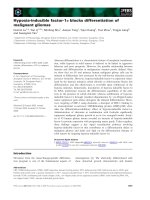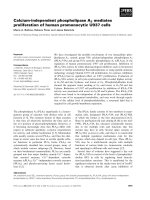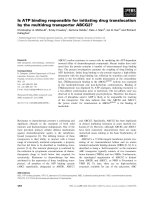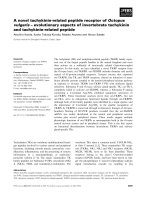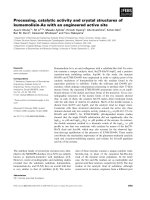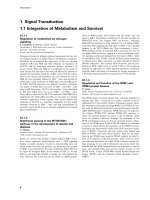Báo cáo khoa học: "Pulmonary echinococcosis mimicking multipl lung metastasis of breast cancer: The role of fluoro-deoxy-glucose positron emission tomography" pot
Bạn đang xem bản rút gọn của tài liệu. Xem và tải ngay bản đầy đủ của tài liệu tại đây (1.06 MB, 4 trang )
BioMed Central
Page 1 of 4
(page number not for citation purposes)
World Journal of Surgical Oncology
Open Access
Case report
Pulmonary echinococcosis mimicking multipl lung metastasis of
breast cancer: The role of fluoro-deoxy-glucose positron emission
tomography
Yavuz Kurt*
1
, Qlker Sücüllü
1
, Ali Qlker Filiz
1
, Muammer Urhan
2
and
Mehmet Levhi AkRn
1
Address:
1
Department of General Surgery, GATA Haydarpasa Istanbul, Turkey and
2
Department of Nuclear Medicine, GATA Haydarapasa Istanbul,
Turkey
Email: Yavuz Kurt* - ; Qlker Sücüllü - ; Ali Qlker Filiz - ;
Muammer Urhan - ; Mehmet Levhi AkRn -
* Corresponding author
Abstract
Background: Echinococcosis is still a serious problem particularly in endemic areas such as South
and Central America, Mediterranean countries, and Russia. Furthermore, hydatid cysts of the lung
are often indistinguishable from a variety of other pulmonary lesions such as lung tumors
Case presentation: We herein present a 56 year old woman with breast cancer who presented
with bilateral pulmonary nodules due to echinococcosis granulosis that mimicked metastatic breast
cancer to the lung.
Conclusion: During the evaluation of the malignancies which could metastasize to the lung, it must
be kept in mind that the appearance of bilateral multiple pulmonary masses can also be the sign of
a pulmonary echinococcosis especially in endemic areas. FDG-PET with its known high negative
predictive value in characterizing indeterminate pulmonary nodules >1 cm is very helpful to
characterize this kind of lesions.
Background
Echinococcosis is a parasitic infestation caused by larvae
of the tapeworm echinococcus. Although there are four
species the vast majority of hydatid disease in humans are
caused by echinococcus granulosis which causes cystic
echinococcosis and has a worldwide distribution. Echino-
coccus multilocularis causes alveolar echinococcosis
which can be seen less frequently in humans. In cystic
echinococcosis humans are an aberrant host and are usu-
ally infected by oral ingestion of excrement from an
infected dog. Infected red fox has an important role for
alveolar echinococcosis [1,2]. Parasitic eggs turned to lar-
vae form after ingestion in the intestine and migrate to the
other organs by penetrating intestinal wall and then
develop cystic or alveolar echinococcosis. The liver and
lungs are the most common involved organs. Hydatid
cysts may rupture, can become secondarily infected, or
may infect other organs. Alveolar echinococcosis behaves
like a malignant tumor biologically. Humans Echinococ-
cosis is still a serious problem particularly in endemic
areas such as South and Central America, Mediterranean
countries, Australia and Russia. Furthermore, hydatid
cysts of the lung are often indistinguishable from a variety
of other pulmonary lesions such as lung tumors [2-4].
Published: 21 January 2008
World Journal of Surgical Oncology 2008, 6:7 doi:10.1186/1477-7819-6-7
Received: 15 January 2007
Accepted: 21 January 2008
This article is available from: />© 2008 Kurt et al; licensee BioMed Central Ltd.
This is an Open Access article distributed under the terms of the Creative Commons Attribution License ( />),
which permits unrestricted use, distribution, and reproduction in any medium, provided the original work is properly cited.
World Journal of Surgical Oncology 2008, 6:7 />Page 2 of 4
(page number not for citation purposes)
Case presentation
A 56-year old woman admitted with a breast lump,
chronic cough and chest pain. There was no medical or
family history of note. On physical examination we dis-
covered a palpable mass in the medial outer quadrant of
the right breast and ipsilateral palpable axillary and supr-
aclavicular lymph nodes. Mammography and ultrasound
revealed a 2 cm nodule with irregular border including
micro calcifications which was confirmed to be invasive
ductal carcinoma by a fine needle biopsy. Chest radiogra-
phy and computed tomography showed multiple nodules
and masses involving both lungs highly suspicious to be
metastatic in origin (Figure 1). Positron Emission Tomog-
raphy (PET) scans showed increased Fluoro-deoxy-glu-
cose (FDG) uptake in the breast cancer and axillar,
supraclavicular lymph nodes as it's expected but there is
no FDG uptake in pulmonary lesions suggesting a benign
origin (Figure 2). She was coming from the east part of the
country where hydatid disease is endemic. Positive indi-
rect hemaglutination test supported the diagnosis of pul-
monary echinococcosis. Chemotherapy for Stage IIIC
breast cancer (Adriamycin, cyclophosphamid and paclit-
axel) and albendazol treatment began for the patient.
Discussion
Hydatid disease is one of the most important helminthic
diseases. Echinococcosis is worldwide in distribution; it
occurs most commonly in sheep and cattle-raising areas
[4]. Lung is the second most common involved organ but
it is hard to distinguish pulmonary echinococcosis from a
variety of other pulmonary lesions especially metastatic
lesions to the lung. In women, the appearance of metasta-
sis is a frequent complication of breast cancer. The lung is
the second most common organ for metastasis of breast
cancer after the bone [5]. We present herein a patient with
breast cancer who had also bilateral pulmonary multiple
masses in different size and irregular shape which were
determined by plain X-Ray and thorax CT thought to be
metastasis to lung. Despite increased FDG uptake for
breast cancer and metastatic lymph nodes, pulmonary
nodules and masses had no FDG uptake so we excluded
malignancy by FDG-PET scan and decided with a high
degree of certainty that they were benign lesions. In fact
there is a wide differential diagnosis for multiple nodules
and masses with extensive pulmonary involvement on
radiography or computed tomography, which includes
pulmonary echinococcosis. But they are not as accurate as
FDG PET to exclude the metastatic pulmonary lesions
especially >1 cm. Needle biopsy or aspiration of the
hydatid cysts since anaphylactic shock would not neces-
sary develop when draining a pulmonary abscess or other
cystic lesions rather than echinococcosis [2].
A study by Schirrmeister et al showed that whole body
FDG PET is as accurate as panel of imaging modalities cur-
rently employed and significantly more accurate in detect-
ing multifocal disease, lymph node involvement and
distant metastasis [6]. FDG PET has been shown to have
impact on the staging and management of recurrent or
metastatic breast cancer in cases of suspicion and in a fol-
low-up setting. The current oncological situation can be
clarified with a single basic imaging modality [6,7].
There is no doubt that multiple pulmonary nodules may
be commonly seen in patients with inflammatory diseases
such as echinococcosis but we want to emphasize in this
manuscript that it is hard to differentiate whether these
nodules are malign or not especially in patients with
malignancy. At this point FDG Pet scan can be helpful by
showing the high metabolic activity of the nodules. Even
though Stumpe et al [1] found that in patients with alveo-
lar echinococcosis baseline PET scans showed multifo-
cally increased FDG uptake in the hepatic lesions'
periphery, liver lesions were FDG negative in patients with
cystic echinococcosis.
Conclusion
FDG-PET besides being a strong indicator of malignant
lung nodules, is a reliable diagnostic test that can avert
needle biopsy of lesions that do not show significant met-
abolic activity. During the evaluation of the malignancies
which could metastasize to the lung, it must be kept in
mind that the appearance of bilateral multiple pulmonary
masses can also be the sign of a pulmonary echinococco-
sis especially in endemic areas. FDG-PET with its known
high negative predictive value in characterizing indetermi-
Chest radiography shows multiple nodules and masses involving both lungsFigure 1
Chest radiography shows multiple nodules and masses
involving both lungs.
World Journal of Surgical Oncology 2008, 6:7 />Page 3 of 4
(page number not for citation purposes)
FDG PET scans, First Column of the Figure showed increased FDG uptake in both breast cancer and in metastatic axillary and supraclavicular lymph nodes (arrows) and also no FDG Uptake of the benign pulmonary lesions (small arrows)Figure 2
FDG PET scans, First Column of the Figure showed increased FDG uptake in both breast cancer and in metastatic axillary and
supraclavicular lymph nodes (arrows) and also no FDG Uptake of the benign pulmonary lesions (small arrows).
Publish with BioMed Central and every
scientist can read your work free of charge
"BioMed Central will be the most significant development for
disseminating the results of biomedical research in our lifetime."
Sir Paul Nurse, Cancer Research UK
Your research papers will be:
available free of charge to the entire biomedical community
peer reviewed and published immediately upon acceptance
cited in PubMed and archived on PubMed Central
yours — you keep the copyright
Submit your manuscript here:
/>BioMedcentral
World Journal of Surgical Oncology 2008, 6:7 />Page 4 of 4
(page number not for citation purposes)
nate pulmonary nodules >1 cm is very helpful to charac-
terize this kind of lesions
Competing interests
The author(s) declare that they have no competing inter-
ests.
Authors' contributions
YK drafted the manuscript, ÝS helped in preparing the
manuscript, AÝF did literature search and helped with
manuscript, MU helped with the nuclear medicine com-
ponent of manuscript, MLA helped with preperation of
manuscript.
All authors read and approved the final manuscript.
Acknowledgements
Written informed consent was obtained from the patient for publication of
this case report
References
1. Stumpe KD, Renner-Schneiter EC, Kuenzle AK, Grimm F, Kadry Z,
Clavien PA, Deplazes P, von Schulthess GK, Muellhaupt B, Ammann
RW, Renner EL: F-18-fluorodeoxyglucose (FDG) positron-
emission tomography of Echinococcus multilocularis liver
lesions: prospective evaluation of its value for diagnosis and
follow-up during benzimidazole therapy. Infection 2007,
35:11-18.
2. Morar R, Feldman C: Pulmonary echinococcosis. Eur Respir J
2003, 21:1069-1077.
3. Erdogan A, Ayten A, Demircan A: Methods of surgical therapy in
pulmonary hydatid disease: is capitonnage advantageous?
ANZ J Surg 2005, 75(11):992-6.
4. Gencer M, Ceylan E: Pulmonary echinococcosis with multiple
nodules mimicking metastatic lung tumor in chest radiogra-
phy. Respiration in press. 2006 Jan 23
5. Bland KI, Vezeridis MP, Copeland EM: Breast. In Principles of Surgery
7th edition. Edited by: Schwartz SI. New York, PA: McGraw-Hill;
1999:558-9.
6. Schirrmeister H, Kuhn T, Guhlmann A, Santjohanser C, Horster T,
Nussle K, Koretz K, Glatting G, Rieber A, Kreienberg R, Buck AC,
Reske SN: Fluorine-18 2-deoxy-2-fluoro-D-glucose PET in the
preoperative staging of breast cancer: comparison with the
standard staging procedures. Eur J Nucl Med 2001, 28:351-358.
7. Siggelkow W, Zimny M, Faridi A, Petzold K, Buell U, Rath W: The
value of positron emission tomography in the follow-up for
breast cancer. Anticancer Res 2003, 23:1859-1867.



